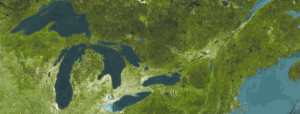
Satellite photo of Great Lakes and St. Lawrence Seaway. Image from NOAA Great Lakes Environmental Research Laboratory (CC BY-SA 2.0).
It is time to make America resilient. The trends have been moving us in the wrong direction for a long time, but we know how to reverse them.
Planners — and elected officials — have to embrace the science that will inform us best on how to achieve that goal, and we have to develop the political will to decide that public safety in the face of natural hazards is central both to fiscal prudence and the kind of nation we want to be. America will not become great by being short-sighted.
Damage from natural disasters is taking an increasing toll on our society and our economy. The National Oceanic and Atmospheric Administration (NOAA), currently the target for serious budget cuts by the Trump administration, operates the National Centers for Environmental Information (NCEI), a vital national resource center for data. It has long tracked the number and costs of the nation’s weather and climate-related disasters, and the conclusion is unavoidable: The number of billion-dollar disasters is growing and getting worse.
APA’s Hazards Planning Center has long studied and highlighted best planning practices for addressing the vulnerabilities that lead to such disaster losses. However, the uptake into community planning systems varies, and it is often a long process challenged by resource shortages.
In recognition of Water Week, I offer the following recommendations to Congress for ways in which federal partners and planners can work together to create stronger, more resilient communities:
Maintain funding levels
Maintaining the necessary funding support for agencies like NOAA is critical for providing us with the baseline information the nation needs to track data. It’s only through the ongoing coordination, maintence, and strengthening of national data resources that federal partners will truly be able to support local planning efforts. More data — not less — is the key to creating hazards policy that prepares communities for the future.
Translate science into good public policy
It is important to find new and better ways to translate science into good public policy. This is one of the objectives for NOAA’s Regional Coastal Resilience program — just one of the many important grants in danger of being defunded in FY 2018.
Support America’s coastal communities by ensuring that they benefit from projects directing the nation’s scientific and technical ingenuity to solve problems related to coastal hazards. The price tag is a tiny fraction of what the nation spent on recovery from Hurricane Sandy. The program is clearly a wise investment in our coastal future.
Reauthorize the National Flood Insurance Program
The National Flood Insurance Program expires this year. Reauthorization must include continued support for the flood mapping program so communities have essential baseline information on the parameters of their flooding challenges.
Municipalities and counties need accurate and current flood mapping and data in order to make more informed judgments on both how and where to build. Only then will the nation begin to dial back the volume of annual flood damages.
Pass the Digital Coast Act
Passing the Digital Coast Act means authorizing and enabling NOAA to provide the suite of tools, data, and resources under the Digital Coast program that have proved useful to local planners, coastal resource managers, public works departments, and water agencies in better managing coastal zones and the natural systems that keep them healthy.
Through the Digital Coast Partnership, APA has been a strong advocate for formalizing NOAA’s Digital Coast project through legislation and providing adequate federal appropriations for robust funding.
This legislation already has bipartisan support because the program shows government at its best in providing cost-effective support to scientifically informed public policy and decision making.
As APA Past President Carol Rhea, FAICP, has noted, “This legislation will directly improve local disaster response and hazard mitigation planning. This bill will help local communities minimize potential loss of life and damage to infrastructure, private property, and conservation areas. The Digital Coast Act is an important step for effective coastal management.”
Continue funding for the Great Lakes Restoration Initiative
The U.S. Environmental Protection Agency was created partly in response to the sorry condition of the Great Lakes and major tributaries like the Cuyahoga and Maumee Rivers. We have come a long way since then. The lakes and rivers are healthier, and the communities around them are, too. Yet the administration’s budget would zero out such programs despite their megaregional and even international impacts.
Recognize the progress we have made and renew America’s commitment to further improve these major bodies of water. Support coastal resilience along the Great Lakes.
These are not dramatic requests. Mostly, they recognize the slow but steady progress — and the persistent creativity — that has resulted from past commitments. They are, however, critical to successful water policy and to our national future as a resilient nation.
Jim Schwab
This post is reprinted from the APA Blog with permission from the American Planning Association, for which it was produced.
